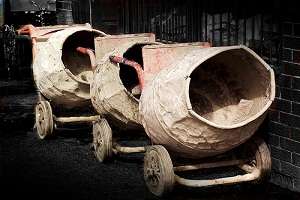Researchers have developed a way to use by-products like fly ash and Bayer liquor to make everyday cement. Credit: Andy Read
Waste from power generators and alumina refineries can now be used to produce an alternative to Portland cement.
Research led by materials scientist Dr Arie van Riessen first investigated using fly ash from power generators as filler for cement products.
"Large amounts of material [are] being deposited in ponds and the like and not being utilised," Dr van Riessen says.
The concrete can be produced using conventional concrete batching plants using a very similar procedure to that employed for Portland cement-based concrete.
"We have, we think, a fantastic synergy whereby we can reduce cost and also help industry get rid of its by-products."
The team added an alkali which dissolved a portion of the fly ash to make a geopolymer which has superb fire-resistant and acid-resistant properties, and impressive mechanical properties.
"The alkali, whether it be sodium hydroxide or sodium silicate, was proving to be the most expensive component," Dr van Riessen says.
Researchers then realised ALCOA's alumina refineries had to replenish Bayer liquor when it became contaminated by impurities.
"We felt 'well, as it's being drained off periodically and then replenished with fresh sodium hydroxide maybe we can use that as a source of alkali," he says.
"Now we have fly ash plus Bayer liquor as two starting materials, both of them being industry by-products.
"Some of the contaminants and the like that are in the Bayer liquor also are being encapsulated into the final geopolymer just as an added bonus.
"Basically you look for fly ash that has the right sort of composition and then you just have to add to it an alkali."
"The Bayer geopolymer seems to have good mechanical properties and all the other benefits of low CO2 production."
He says they mix it for five to 10 minutes, before treating it in one of two ways.
"Once we have mixed it and poured it into the moulds we can put it into an oven, about 700C and just leave it to set and cure overnight.
"If we need to make an ambient-cured material we can't cure it in an oven.
"We add a little bit of lime, the lime can be either directly calcium oxide or calcium hydroxide, or it can be from a slag which has lime in it."
The addition of sand produces a mortar, and concrete can be produced by adding coarse aggregate, as well as sand.
More information: The paper Van Riessen et al Bayer-geopolymers: An exploration of synergy between the alumina and geopolymer industries is published in Cement & Concrete Composites 41 (2013) 29–33. www.sciencedirect.com/science/ … ii/S0958946513000759
Provided by Science Network WA























